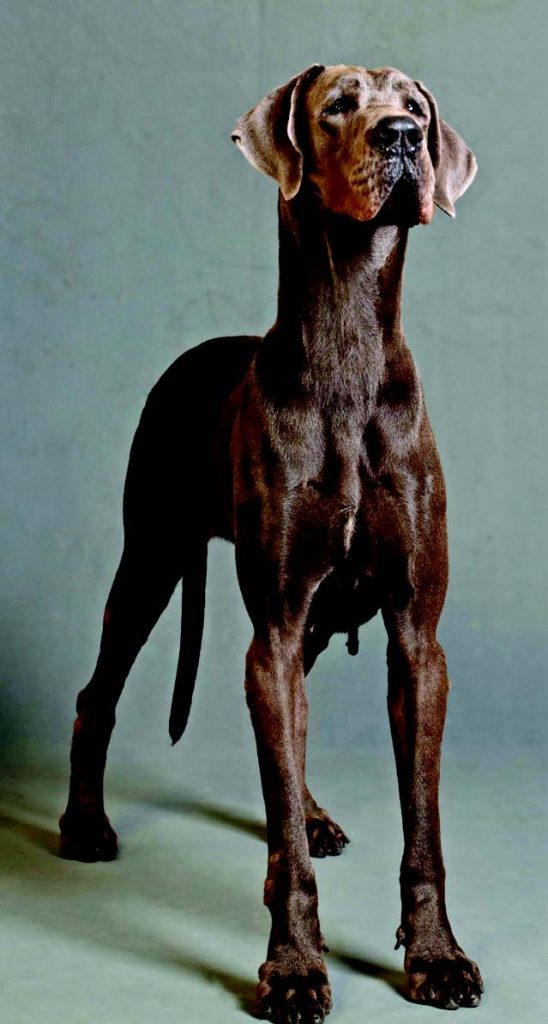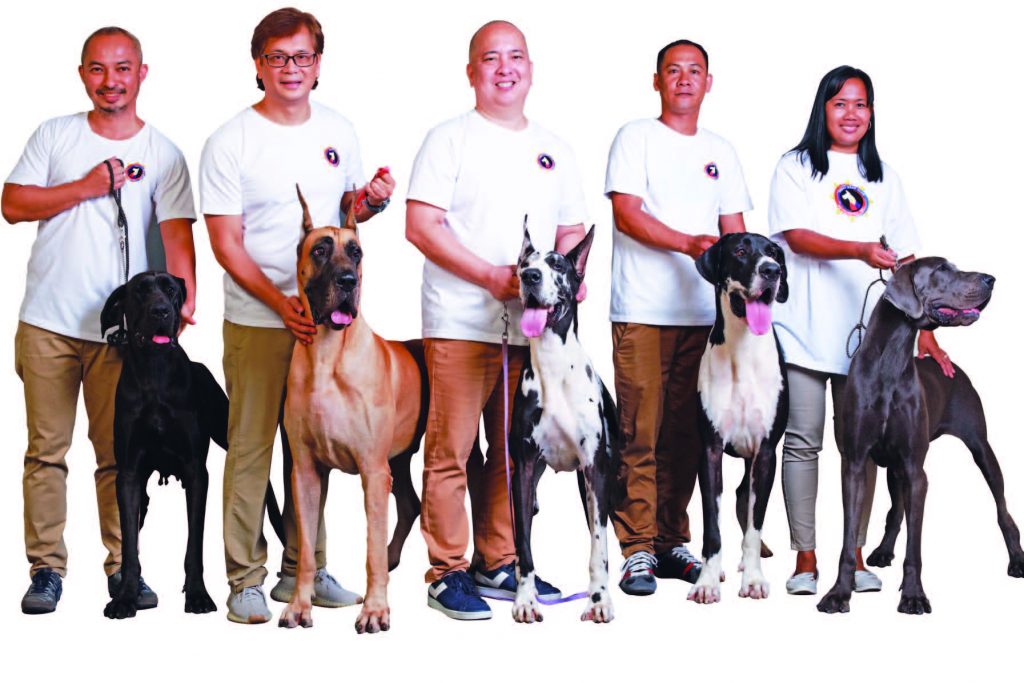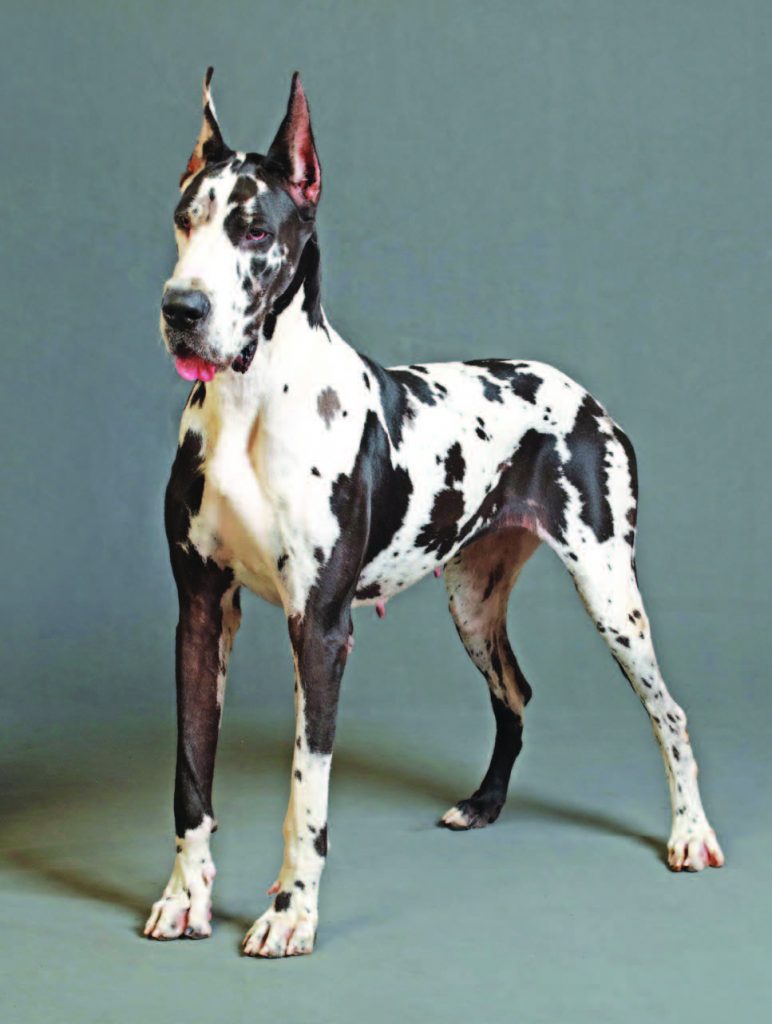The Great Dane, often referred to as a “Gentle Giant” because of their large size and laid-back personality, originated in Germany. They may appear intimidating at first because of their huge size, but people soon learn that they are one of the most good-natured breeds out there. Great Danes are known for being lap-dogs yet are also protective of their human companions without being overly aggressive.

With a typical height of 30 to 32 inches for males and 28 to 30 inches for females at the shoulders, Great Danes stand as one of the tallest dog breeds in the world, towering over other canines and small children.
Apart from their gigantic stature, Great Danes are also famed for their regal appearance, grace, and power, earning them the name the “Apollo of Dogs.”
Tall, dark, and handsome with a pleasing personality – Great Danes are a dog lover’s dream companion.
Interview
Animal Scene interviewed Jose Ma Ignacio, human companion of Phil Ch Ororo von Daneland, to talk about what makes the Great Dane so special.
Q: WHAT WAS THE STORY BEHIND YOUR LOVE FOR THE BREED?
“When I was a boy, my mother Leonora used to tell us stories of how our grandfather, Jose Padilla Jr., had [taken care of] big dogs in the 1950s and 60s. He had German Shepherd Dogs, Dobermans, and the biggest of the lot, Great Danes.
He also starred in a movie, Mutya Ng Pasig wherein he [had] a Great Dane as a companion animal.”
His mother apparently also had encounters with Great Danes as a young girl. “My mother also told a story of how when she and her sisters would go to school at the Holy Ghost, the dogs would accompany them and be trained by none other than the nuns of the school.”
Aside from his family’s stories, pop culture also played an influence on his love for the breed. “There were also the movies, Swiss Family Robinson and [Disney’s] The Ugly Dachshund that featured fawn Great Danes.” “All of these made an impression on me as a kid,” Ignacio said. It is due to these influences that they were the only breed that he wanted to take care of ever since. In 1999, already working and earning for himself, he took home his first Great Dane, Anderson Ariel of JCD.
Q: WHAT ATTRACTED YOU TO THE BREED?

“I was attracted to their majesty. They are a breed unlike any other. Living with them is perfect for me. They love you unconditionally.”
And as Ignacio was brave enough to say, “It’s like having a BFF that does not argue with you or a wife or girlfriend [who] does not nag!”
Q: WHAT MAKES THE GREAT DANE UNIQUE?
“They are unique in that you will not confuse a well-bred Great Dane with any other breed. He is not coarse like a mastiff or too refined like a greyhound. He must have power, speed, and courage.”
While all dogs have special qualities that make them unique, Ignacio said that what makes them all similar is that they all “need to be loved and [be] well-taken cared of” by their guardian.
Q: DO YOU HAVE OTHER COMPANION ANIMALS UNDER YOUR CARE? AND DO YOUR GREAT DANES GET ALONG WELL WITH THEM?
“My son Tristan has two ball pythons and there are about four puspins in our compound and they all get along extremely well.”
Q: WHAT IS THE GREAT DANE’S “GREATEST” CHARACTERISTIC OR TRAIT?
“I would say that it’s a tie between [their] unconditional love for [their human] and [their] beauty.”
Q: ARE THERE ANY CHALLENGES THAT COME WITH CARING FOR THEM?
“Aside from the obvious expenses associated with giant dogs, they also don’t have very long lifespans.”
Ignacio exclaimed that he accepts the risk of having eight short years with them, expressing that this is how special they are to him.
Q: FINALLY, COULD YOU SHARE SOME IMPORTANT TIPS IN TAKING CARE OF A GREAT DANE?
1. “DO get pet insurance. If not, save money because giant dogs equal giant expenses.”
2. “DON’T overfeed growing puppies, [as] it will lead to skeletal problems.”
3. “DON’T breed if you lack the knowledge. You will only have heartbreak.”
No love for “backyard breeders”
In her recent article for SprucePets.com titled “Signs of a Bad Breeder or a Backyard Breeder”, veterinary technician Jenna Stregowski, RVT discussed why backyard breeders should be avoided.

She said, “Some breeders are just looking to make a profit off of so-called purebred dogs that they own. They may let dogs reproduce freely without knowledge of their family histories (health and behavioral, in particular). They pay little or no attention to genetic health issues in both the parents and the puppies.”
Ideally, it would be best to adopt dogs in sanctuaries who are badly in need of loving homes. Many animal rescue organizations like PAWS or Pasay Pups have dogs available for adoption the whole year round.
If there’s something strange in your neighborhood…
Apparently, you can call a Great Dane. Aside from their already perfect profile, Great Danes are known to be a little bit of a mystic too. In their book, The Mythology of Dogs: Canine legend and lore through the ages, Gerald Hausman and Loretta Hausman state that because Great Danes seem to have the ability to see things that are not there, they were once believed to ward off ghosts and evil spirits.
As proof, Ignacio shared a story about his own experience of the Great Dane’s ghost-busting abilities. “There was a time in 2009 that I was living in a big, old house in Silang as part of my duty as a Community Immersion Instructor. During my orientation, the neighbors and even the landlord warned me of spirits in the house that go bump at night. During the first few nights, [my students and I] did hear strange noises that could not be explained. We could not get a good night’s sleep because the noises would wake us up.”
As soon as he got the chance, he brought his female mantle Great Dane to the house, and as you guessed it, having her there seemed to work as Ignacio said that he “slept like a baby every night thereafter”.

He said, “You see, I learned in one documentary that Great Danes were mystical creatures and could ward off evil spirits. Well, you will never know unless you try it!”
The popular animated character Scooby Doo, who helps “meddling kids” solve mysteries, was a Great Dane after all.
How to spot a Great Dane (Based on the Federation Cynologique Internationale’s Breed Standard for the Great Dane)
HEAD: Long, narrow, distinct and expressive. Finely chiselled, especially under the eyes. The distance from tip of nose to stop and from stop to the slightly defined occipital bone should be as equal as possible. The upper lines of muzzle and skull should run parallel. The head must appear narrow seen from the front with bridge of nose as broad as possible.
NOSE: Well developed, more broad than round with large nostrils. Must be black with the exception of harlequins (white with black patches). In these, a black nose is desired but a butterfly nose (black with pink patches) or flesh coloured nose. In blue dogs, the colour of the nose is anthracite (diluted black).
MUZZLE: Deep and as rectangular as possible. Bridge of nose must never be concave (dish shaped), convex (roman nose) or falling away in front part (eagle nose).
LIPS: Well defined corners of lips. Lips neither lacking flews nor being too pendulous or rolled in. Dark pigmented lips.
JAWS/TEETH: Well developed broad jaws. Strong sound and complete scissor bite (42 teeth according to the dentition formula).

EYES: Of medium size with lively friendly intelligent expression. Almond shaped with close fitting lids. Eyes not set too wide apart or slit eyes.
EARS: Naturally pendant set on high, but not lifted above skull or hanging low. Medium sized. Front edges lying close to cheeks but neither hanging flat nor standing off from sides of head.
NECK: Long, clean, muscular and never short or thick. Well formed set on, tapering slightly towards the head, with arched neckline. Carried upright but inclined slightly forward.
BODY:
WITHERS: The highest point of the strong body. It is formed by the points of the shoulder blades which extend beyond the spinal processes.
BACK: Short and firm, in almost straight line falling away imperceptibly to the rear. Back never to be long or with top line rising towards the rear.
LOIN: Slightly arched, broad, strongly muscled.
CHEST: Reaching to the elbows. Well sprung ribs, reaching far back. Ribs must never be barrel shaped or flat. Chest of good width and depth and must never look flat sided or shallow. Well marked forechest, although breastbone must not be too strongly pronounced.
UNDERLINE AND BELLY: Belly well tucked up towards rear, forming a nicely curved line with the underside of the brisket.
TAIL: Reaching to the hocks, must not be too long or too short. Set on high and broad, neither too high nor too low. Not too thick, tapering evenly towards tip. In repose tail is hanging down with natural curve. When the dog is alert or moving the tail is carried slightly sabre-like but not markedly above the backline, must never be carried above the back line.
FOREQUARTERS: Must be sufficiently angulated and with strong bone and muscles.
HINDQUARTERS: The whole skeleton is covered by strong muscles which make the croup, hips and upper thighs appear broad and rounded. The strong well angulated hind legs, viewed from behind, are parallel to the front legs.
GAIT / MOVEMENT: Harmonious, lithe, covering a lot of ground, slightly springy. Never with a short stride or pacing. Legs must be parallel in movement, both coming and going and always well coordinated between front and rear.
SKIN: Tight fitting. In solid colours, well pigmented. In harlequins, the distribution of pigment mainly corresponds to the markings.
COAT:
HAIR: Very short, dense, smooth and close lying, glossy. Must never be coarse, dull or a double coat.
COLOUR: The Great Dane is bred in three separate colour varieties: Fawn and brindle, harlequin and black, and blue.
SIZE:
Height at the withers: Males: at least 80 cms, should not exceed 90 cms.
Females: at least 72 cms, should not exceed 84 cms.
Breed information
(Information for General Appearance and Behavior/Temperament are based on the Federation Cynologique Internationale’s Breed Standard for the Great Dane)
GENERAL APPEARANCE: The Great Dane in his noble appearance combines a large, powerful well constructed body with pride, strength and elegance. By substance together with nobility, harmonious appearance, well proportioned outlines, as well as an especially expressive head, the Great Dane strikes the onlooker as a noble statue, never coarse or with refined elegance. Perfect in balance and always with clearly defined sexual dimorphism. He is the Apollo amongst all breeds.
BEHAVIOR/TEMPERAMENT: Friendly, loving and devoted to his owners. Might be reserved towards strangers, but required is a confident, fearless, easily tractable, docile companion and family dog with high resistance to provocation and without aggression.
DIET: “Regarding feeding, each individual will be different from next one. There is no magic dog food that can be fed to all of them (good luck with that!) You have to see what each dog will thrive on,” Ignacio advised.
TRAINING: According to RegalDaneRescue.com, training is essential to be able to manage and handle such a huge dog. As with other dogs, training should be done as early as possible when they are still puppies. “It is essential to teach young Great Danes not to jump up on people. Their size in a few short months can harm an adult person if left to do so. Don’t wait until they are 6 months old or you will have trouble containing the head-strong personality.” Training should be continuously practiced well into adulthood.
Great Dane, Great Dog
Beautiful? Check. Sweet? Check. Protective? Check. Great Danes seem too good to be true… and they actually are! On top of their already great characteristics, their unassuming nature is what makes their breed so lovable. We now understand why Ignacio is so captivated by his furry companions so much. What else can we say? Great Danes are truly a great breed indeed.
Great Danes and world records

On October 4, 2011, The Guinness World Records granted the title of “tallest dog ever” to a Great Dane named Zeus. He is 111.8 cm (44 in) tall and is a companion of Denise Doorlag and her family, of Michigan, USA.
According to the Guinness World Records website, “Zeus weighed 70.30 kg (155 lb) and ate approximately 13.6 kg (30 lb) of food every two weeks. When standing, Zeus reached an astonishing 2.23 m (7 ft 4 in) tall!”
As a certified therapy dog, Zeus regularly visited people at a hospital near their home. Sadly, in September 2014, Zeus passed away at the age of five.
The current title holder for “the tallest dog living” is Freddy, also a Great Dane, from Leigh-on-Sea, UK. He is 103.5 cm (3 ft 4.75 in) tall when he was measured in his guardian Claire Stoneman’s home on 13 September 2016.
This appeared in Animal Scene magazine’s January 2020 issue.
You might want to read:
– Mutated genes may have caused some dog breeds to have trouble breathing
– Against all odds: Giving home even to the fiercest of breeds
– American Bulldog: Bad bully or best buddy






